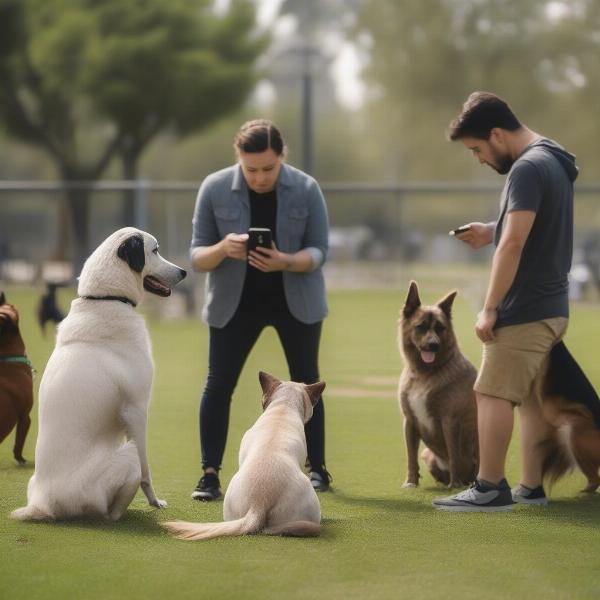When other dogs attack your dog, it can be a terrifying experience. Understanding why dog aggression occurs, how to prevent attacks, and what to do if an attack happens is crucial for every dog owner. This guide will provide you with practical advice and strategies to help you navigate these challenging situations and keep your canine companion safe.
Understanding Dog Aggression
Dog aggression isn’t always straightforward. It can stem from various factors, including fear, territoriality, possessiveness, pain, or even learned behavior. Identifying the underlying cause of aggression is key to addressing the issue effectively. For example, a dog that attacks out of fear might react differently than one displaying dominance-based aggression.
Fear-Based Aggression
Dogs exhibiting fear-based aggression often display submissive body language alongside aggressive displays, like tucked tails, flattened ears, and whale eyes. They might attack when cornered or feeling threatened.
Territorial Aggression
Territorial aggression manifests when a dog defends its perceived territory, be it their home, yard, or even their owner. They might bark, lunge, or bite to ward off perceived intruders.
Preventing Dog Attacks
Prevention is always better than cure. Here are several steps you can take to minimize the risk of your dog being attacked:
- Socialization: Early and ongoing socialization is paramount. Exposing your dog to various dogs, people, and environments from a young age can help them develop appropriate social skills and reduce fear-based reactivity.
- Training: Obedience training is vital. A well-trained dog is more likely to respond to your commands, allowing you to control them in potentially dangerous situations. Focus on commands like “come,” “stay,” and “leave it.”
- Awareness: Be aware of your surroundings. Observe other dogs’ body language and avoid situations that could trigger aggression.
 Observing dog body language at the dog park If you see a dog displaying aggressive signals, steer clear.
Observing dog body language at the dog park If you see a dog displaying aggressive signals, steer clear. - Avoid High-Risk Areas: Be cautious in areas where unleashed dogs are common, even if it’s legal. Opt for designated dog parks or controlled environments where you can better manage interactions.
- Leash Control: Keeping your dog on a leash in public places provides control and prevents unwanted interactions. A secure leash and harness can also prevent your dog from escaping and potentially escalating a conflict.
What to Do if Your Dog is Attacked
Despite your best efforts, attacks can still happen. Knowing how to react can make a crucial difference:
- Don’t Panic: While difficult, try to remain calm. Panicking can escalate the situation and make it harder to react effectively.
- Don’t Intervene Directly: Avoid putting yourself directly between the dogs. You risk getting bitten. Instead, try to create a distraction.
- Make Noise: Loud noises, like clapping, shouting, or blowing a whistle, might startle the attacking dog and break up the fight.
- Use a Barrier: If possible, use a barrier like a jacket, backpack, or even a trash can lid to separate the dogs.
- Seek Veterinary Attention: Even if the injuries seem minor, seek veterinary care immediately. Internal injuries or infections might not be immediately apparent.
Conclusion
Dealing with dog attacks is a serious issue. By understanding dog aggression, taking preventative measures, and knowing how to react in an emergency, you can significantly reduce the risk to your dog. Remember, being proactive and informed is the best way to ensure your dog’s safety and well-being. Always prioritize your dog’s safety and seek professional help if needed.
FAQ
- What should I do if my dog bites another dog? Exchange contact information with the other owner and seek veterinary care for both dogs. Consult with an animal behaviorist to address the underlying cause of your dog’s aggression.
- Is it legal to use pepper spray on an attacking dog? Laws vary by location, so check local regulations. In some areas, it might be considered animal cruelty.
- How can I tell if a dog is about to attack? Look for signs of aggression such as growling, snarling, bared teeth, stiff posture, and direct staring.
- Should I try to physically restrain my dog during an attack? Avoid physically restraining your dog as you risk being bitten. Try to create a distraction instead.
- What if the other dog owner is uncooperative after the attack? Document the incident thoroughly, take photos if possible, and contact animal control.
- Can I sue the owner of the attacking dog? Consult with a legal professional to explore your options, especially if significant injuries or damages occurred.
- How can I help my dog recover emotionally after being attacked? Provide a safe and comfortable environment, avoid triggering situations, and consider working with a veterinary behaviorist.
Related Articles on ILM Dog
About ILM Dog
ILM Dog (https://ilmdog.com) is your trusted resource for expert advice on dog care, breed selection, health, training, nutrition, and much more. We provide practical tips and insights to help both new and experienced dog owners navigate all aspects of canine companionship. With a focus on health and training, we strive to empower you with the knowledge and tools needed to nurture a happy, healthy, and well-behaved dog. Contact us at [email protected] or +44 20-3965-8624 for personalized advice and support.